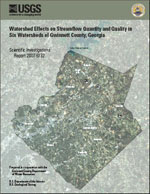Watershed management is critical for the protection and enhancement of streams that provide multiple benefits for Gwinnett County, Georgia, and downstream communities. Successful watershed management requires an understanding of how stream quality is affected by watershed characteristics. The influence of watershed characteristics on stream quality is complex, particularly for the nonpoint sources of pollutants that affect urban watersheds.
The U.S. Geological Survey (USGS), in cooperation with Gwinnett County Department of Water Resources (formerly known as Public Utilities), established a water-quality monitoring program during late 1996 to collect comprehensive, consistent, high-quality data for use by watershed managers. Between 1996 and 2003, more than 10,000 analyses were made for more than 430 water-quality samples. Continuous-flow and water-quality data have been collected since 1998. Loads have been computed for selected constituents from 1998 to 2003.
Changing stream hydrology is a primary driver for many other water-quality and aquatic habitat effects. Primary factors affecting stream hydrology (after watershed size and climate) within Gwinnett County are watershed slope and land uses. For the six study watersheds in Gwinnett County, watershedwide imperviousness up to 12 percent does not have a well-defined influence on stream hydrology, whereas two watersheds with 21- and 35-percent impervious area are clearly impacted. In the stream corridor, however, imperviousness from 1.6 to 4.4 percent appears to affect baseflow and stormflow for all six watersheds.
Relations of concentrations to discharge are used to develop regression models to compute constituent loads using the USGS LOAD ESTimator model. A unique method developed in this study is used to calibrate the model using separate baseflow and stormflow sample datasets. The method reduced model error and provided estimates of the load associated with the baseflow and stormflow parts of the hydrograph.
Annual load of total suspended sediment is a performance criterion in Gwinnett County's Watershed Protection Plan. Median concentrations of total suspended solids in stormflow range from 30 to 180 times greater than in baseflow. This increase in total suspended solids concentration with increasing discharge has a multiplied effect on total suspended solids load, 97 to 99 percent of which is transported during stormflow. Annual total suspended solids load is highly dependent on annual precipitation; between 1998 and 2003 load for the wettest year was up to 28 times greater than for the driest year. Average annual total suspended solids yield from 1998-2003 in the six watersheds increased with high-density and transportation/utility land uses, and generally decreased with low-density residential, estate/park, and undeveloped land uses.
Watershed characteristics also were related to annual loads of total phosphorus, dissolved phosphorus, total nitrogen, total dissolved solids, biochemical oxygen demand, and total zinc, as well as stream alkalinity.
Flow-adjusted total suspended solids, total phosphorus, and total zinc stormflow concentrations between 1996 and 2003 have a seasonal pattern in five of the six watersheds. Flow-adjusted concentrations typically peak during late summer, between July and August. The seasonal pattern is stronger for more developed watersheds and may be related to seasonal land-disturbance activities and/or to seasonal rainfall intensity, both of which increase in summer. Adjusting for seasonality in the computation of constituent load caused the standard error of annual total suspended solids load to improve by an average of 11 percent, and increased computed summer total suspended solids loads by an average of 45 percent and decreased winter total suspended solids loads by an average of 40 percent. Total annual loads changed by less than 5 percent on the average.
Graphical and statistical analyses do not indicate a time tre


